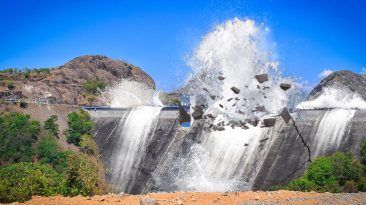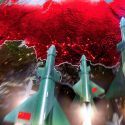The time for talk is over. Now the biggest countries on Earth are fighting for global supremacy. What would happen if the United States started World War III? Who would the U.S. attack first? Could we use robot soldiers? Or would nuclear power win the day?
Imagine that for decades, the tension between the United States, Russia and China has been rising. Whether it’s through spies or taxes, these nations constantly battle to one-up each other and control the resources on our planet.
While wars of the past started over border disputes and assassinations, World War III could start in a virtual space. And if another cyberattack from China triggers the United States to respond, the conflict could grow into the most devastating war ever known. But if a war started tomorrow, would technology dominate over humans?
World War II claimed about 75 million lives from 1939 to 1945. It left Japan and Europe in shambles and scarred a generation. But if the United States starts World War III, the death toll could be much higher and happen faster. And with the trade war between the United States and China escalating, the Western superpower could attack one of its biggest rivals. So what weapons would it use to strike first?
Drone technology has changed the face of modern warfare during the past few years. And now, you may not even see it coming. The military could outfit drones with adaptive camouflage, small electronic panels that can display different patterns. These lightweight aircraft could slip right by you, and you wouldn’t know until it’s too late. But what if those drones attacked you?
Weapons manufacturers are developing a compact laser capable of shooting down missiles, aircraft and drones. While your naked eye could miss those high-flying threats, the laser’s powerful beam could track and tear through these drones. And on the ground, soldiers could have the same kind of precision weapons.
Self-steering bullets could change how troops eliminate moving targets when fighting face-to-face. While the U.S. government hasn’t disclosed the details of how this technology works, these bullets have frightening accuracy even in windy conditions. That means each shot could be discharged further away and faster. But as 2020 taught us, populations can be decimated without a bullet ever being fired.
The CDC listed 30 microorganisms and toxins that terrorists could weaponize against a population. With the right delivery systems, these warring nations could use pathogens like the hantavirus or anthrax against each other. While bioweapons are nothing new, most agents lose 50% of their effectiveness in the air due to heat and humidity. But if nations wanted to cause mass destruction, they would unleash the worst weapon they have available.
Although China has over 100 missile silos, the government has said they wouldn’t strike first. But if this war became desperate enough, that could change. The United States owns over 5,600 nuclear missiles. And its political rival Russia has over 6,000 warheads ready to strike. The idea of mutually assured destruction has prevented all sides from using this apocalyptic threat.
But if cyberattacks took down air defenses and missile controls, all bets might be off. One warhead exploded over New York could instantly take out 300,000 people. Moscow and its surrounding areas could suffer almost 200,000 deaths in the blink of an eye. And that’s only if two warheads were launched, one over each city. City after city across the globe could be wiped out in this war to end all wars.
World War III could end all life on Earth if these nations didn’t work out their differences. But what if we tried using these nukes to save the world? What if we nuked an asteroid on course to hit Earth?
Sources
- “World War I Casualties” 2021. centre-robert-schuman.org.
- “Casualties Of World War II | History Of Western Civilization II”. 2021. courses.lumenlearning.com.
- “Ranking: Military Spending By Country 2020 | Statista”. M. Szmigiera. 2021. statista.com.
- “Would China Use Nuclear Weapons First In A War With The United States?”. Gregory Kulacki. 2020. thediplomat.com.
- “What Threat Do China’S New Missile Silos Pose To The US?”. Adam Cabot. 2021. thediplomat.com.



























